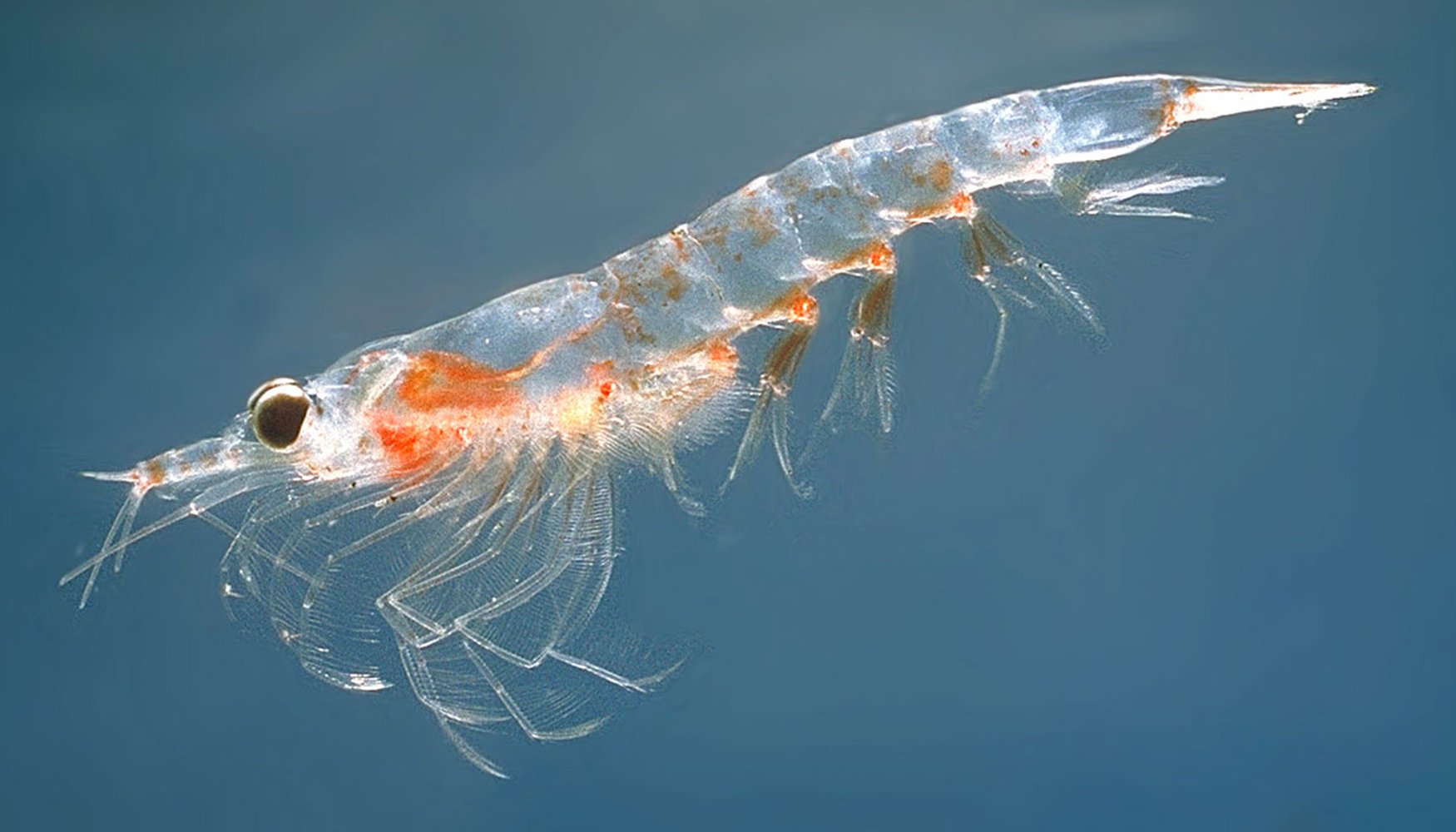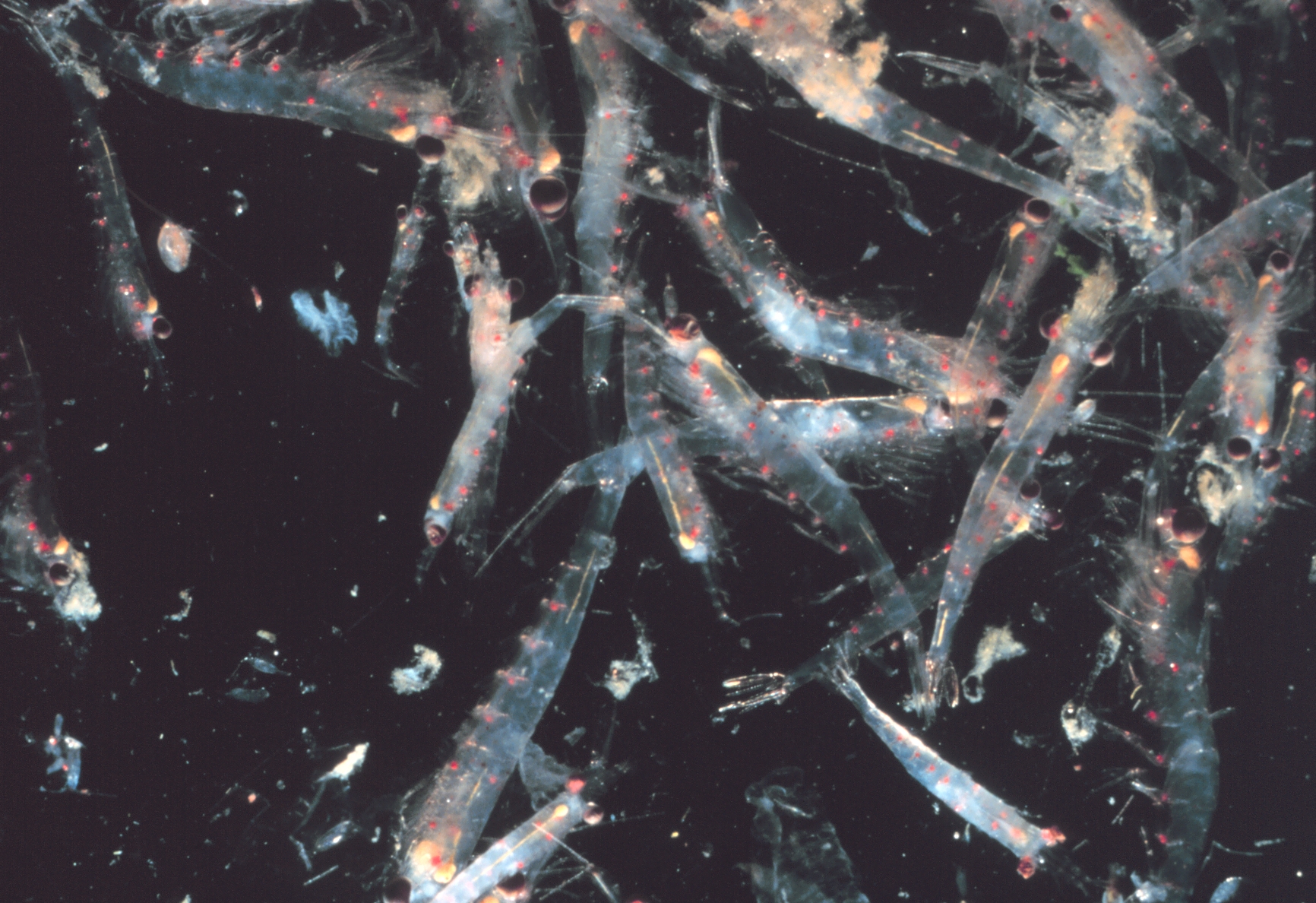Difference between revisions of "Krill"
Westarctica (talk | contribs) (Created page with "thumb|Northern krill '''Krill''' are small crustaceans of the order Euphausiacea, and are found in all the world's oceans. The name "krill" comes f...") |
Westarctica (talk | contribs) |
||
| Line 1: | Line 1: | ||
[[File:Northern-Krill.jpg|thumb|Northern krill]] | [[File:Northern-Krill.jpg|thumb|400px|Northern krill]] | ||
'''Krill''' are small crustaceans of the order Euphausiacea, and are found in all the world's oceans. The name "krill" comes from the Norwegian word ''krill'', meaning "small fry of fish", which is also often attributed to species of fish. | '''Krill''' are small crustaceans of the order Euphausiacea, and are found in all the world's oceans. The name "krill" comes from the Norwegian word ''krill'', meaning "small fry of fish", which is also often attributed to species of fish. | ||
| Line 23: | Line 23: | ||
==Behavior== | ==Behavior== | ||
[[File:Krill swarm.jpg|thumb|Krill swarm]] | [[File:Krill swarm.jpg|thumb|400px|Krill swarm]] | ||
===Feeding=== | ===Feeding=== | ||
Many krill are filter feeders: their frontmost appendages, the thoracopods, form very fine combs with which they can filter out their food from the water. These filters can be very fine indeed in those species (such as ''Euphausia spp.'') that feed primarily on phytoplankton, in particular on diatoms, which are unicellular algae. Krill are mostly omnivorous, although a few species are carnivorous, preying on small zooplankton and fish larvae. | Many krill are filter feeders: their frontmost appendages, the thoracopods, form very fine combs with which they can filter out their food from the water. These filters can be very fine indeed in those species (such as ''Euphausia spp.'') that feed primarily on phytoplankton, in particular on diatoms, which are unicellular algae. Krill are mostly omnivorous, although a few species are carnivorous, preying on small zooplankton and fish larvae. | ||
Latest revision as of 05:47, 9 April 2018
Krill are small crustaceans of the order Euphausiacea, and are found in all the world's oceans. The name "krill" comes from the Norwegian word krill, meaning "small fry of fish", which is also often attributed to species of fish.
Krill are considered an important trophic level connection – near the bottom of the food chain – because they feed on phytoplankton and (to a lesser extent) zooplankton, converting these into a form suitable for many larger animals for which krill make up the largest part of their diets. In the Southern Ocean, one species, the Antarctic krill, Euphausia superba, makes up an estimated biomass of around 379,000,000 tonnes, making it among the species with the largest total biomass. Of this, over half is eaten by whales, seals, penguins, squid, and fish each year, and is replaced by growth and reproduction. Most krill species display large daily vertical migrations, thus providing food for predators near the surface at night and in deeper waters during the day.
Krill are fished commercially in the Southern Ocean and in the waters around Japan. The total global harvest amounts to 150,000–200,000 tonnes annually, most of this from the Scotia Sea. Most of the krill catch is used for aquaculture and aquarium feeds, as bait in sport fishing, or in the pharmaceutical industry.
Krill are also the main prey of baleen whales, including the blue whale.
Distribution
Krill occur worldwide in all oceans, although many individual species have endemic or neritic (i.e., coastal) distributions.
Species with neritic distributions include the four species of the genus Nyctiphanes. They are highly abundant along the upwelling regions of the California, Humboldt, Benguela, and Canarias current systems. Another species having only neritic distribution is E. crystallorophias, which is endemic to the Antarctic coastline.
Species with endemic distributions include the six Euphausia species native to the Southern Ocean.
In the Antarctic, seven species are known, one in genus Thysanoessa (T. macrura) and six in Euphausia. The Antarctic krill (Euphausia superba) commonly lives at depths reaching 100 m (330 ft),[27] whereas ice krill (Euphausia crystallorophias) reach depth of 4,000 m (13,100 ft), though they commonly inhabit depths of at most 300–600 m (1,000–2,000 ft). Both are found at latitudes south of 55° S, with E. crystallorophias dominating south of 74° S and in regions of pack ice. Other species known in the Southern Ocean are E. frigida, E. longirostris, E. triacantha and E. vallentini.
Anatomy
Krill are crustaceans and have a chitinous exoskeleton made up of three tagmata: the cephalon (head), the pereion (fused to the cephalon to form a cephalothorax), and the pleon. This outer shell of krill is transparent in most species. Krill feature intricate compound eyes; some species adapt to different lighting conditions through the use of screening pigments. They have two antennae and several pairs of thoracic legs called pereiopods or thoracopods, so named because they are attached to the thorax; their number varies among genera and species. These thoracic legs include feeding legs and grooming legs. Additionally all species have five pairs of swimming legs called pleopods or "swimmerets", very similar to those of a lobster or freshwater crayfish. Most krill are about 1–2 centimeters (0.4–0.8 in) long as adults; a few species grow to sizes on the order of 6–15 centimeters (2.4–5.9 in). Krill can be easily distinguished from other crustaceans such as true shrimp by their externally visible gills.
Most krill are bioluminescent animals having organs called photophores that can emit light. The light is generated by an enzyme-catalysed chemiluminescence reaction, wherein a luciferin (a kind of pigment) is activated by a luciferase enzyme. Studies indicate that the luciferin of many krill species is a fluorescent tetrapyrrole similar but not identical to dinoflagellate luciferin and that the krill probably do not produce this substance themselves but acquire it as part of their diet, which contains dinoflagellates.
Behavior
Feeding
Many krill are filter feeders: their frontmost appendages, the thoracopods, form very fine combs with which they can filter out their food from the water. These filters can be very fine indeed in those species (such as Euphausia spp.) that feed primarily on phytoplankton, in particular on diatoms, which are unicellular algae. Krill are mostly omnivorous, although a few species are carnivorous, preying on small zooplankton and fish larvae.
Krill are an important element of the aquatic food chain. Krill convert the primary production of their prey into a form suitable for consumption by larger animals that cannot feed directly on the minuscule algae. Northern krill and some other species have a relatively small filtering basket and actively hunt copepods and larger zooplankton.
Predation
Many animals feed on krill, ranging from smaller animals like fish or penguins to larger ones like seals and baleen whales.
Disturbances of an ecosystem resulting in a decline in the krill population can have far-reaching effects. Climate change poses a significant threat to krill populations. Several single-celled endoparasitoidic ciliates of the genus Collinia can infect species of krill and devastate affected populations. Such diseases were reported for Thysanoessa inermis in the Bering Sea and also for E. pacifica, Thysanoessa spinifera, and T. gregaria off the North American Pacific coast. Some ectoparasites afflict krill (and also shrimp and mysids); one such parasite is Oculophryxus bicaulis, which attaches itself to the krill's eyestalk and sucks blood from its head; it apparently inhibits the host's reproduction, as none of the afflicted animals reached maturity.
Preliminary research indicates krill can digest microplastics under 5 mm (0.20 in) in diameter, breaking them down and excreting them back into the environment in smaller form.
Human use
Krill have been harvested as a food source for humans and domesticated animals since at least the 19th century, and possibly earlier in Japan, where it was known as okiami. Large-scale fishing developed in the late 1960s and early 1970s, and now occurs only in Antarctic waters and in the seas around Japan. Historically, the largest krill fishery nations were Japan and the Soviet Union, or, after the latter's dissolution, Russia and Ukraine. The harvest peaked, which in 1983 was about 528,000 tonnes in the Southern Ocean alone (of which the Soviet Union took in 93%), is now managed as a precaution against overfishing.

